
W := W-1 ; H := H-1; function x2i(x : double) : integer; begin x2i := Round((x-xmin)/(xmax-xmin)*W); end; function i2x(i : integer) : double; begin i2x := xmin + i/W*(xmax-xmin); end; function y2j(y : double) : integer; begin y2j := Round(H*(1-(y-ymin)/(ymax-ymin))); end; function j2y(j : integer) : double; begin j2y := ymin + (H-j)/H*(ymax-ymin); end;Then the following program snippet is equivalent with the Axiom of Specification for the inside of a unit circle. Mind the (if then) statement and the (pixels $\to$ world) mapping.
function C(x,y : double) : boolean;
begin
C := sqr(x)+sqr(y) < 1;
end;
procedure tekenen;
var
i,j,k : integer;
p,q : double;
begin
{ Axiom of Specification }
for j := 0 to H-1 do
begin
for i := 0 to W-1 do
begin
if C(i2x(i),j2y(j)) then
Form1.Image1.Canvas.Pixels[i,j] := clRed;
end;
end;
end;
It is noticed that there is no other way within the context of Implementable Set Theory,
because there are no other sets than bit patterns in computer memory. The latter in turn are
equivalent to natural numbers. And that's all. Whatever. The output is something like this:

Another open sentence for the elements of our screen $\mathbb{R}^2$ - in world coordinates - can be defined. Is there any equation for triangle?. The answer is yes. So let's have a look at the inside $D(x,y)$ of an arbitrary triangle, with vertices $(x_1,y_1),(x_2,y_2),(x_3,y_3)$:
function min(a,b,c : double) : double; var m : double; begin m := a; if b < a then m := b; if c < m then m := c; min := m; end; function D(x,y : double) : boolean; var xi,eta,det : double; begin det := (x2-x1)*(y3-y1)-(x3-x1)*(y2-y1); xi := ((y3-y1)*(x-x1)-(x3-x1)*(y-y1))/det; eta := ((x2-x1)*(y-y1)-(y2-y1)*(x-x1))/det; D := min(xi,eta,1-xi-eta) > 0; end;Or consider the open sentence for the elements of a half plane delimited by a line with support $(p_1,q_1),(p_2,q_2)$:
function L(x,y : double) : boolean; begin L := (q2-q1)*(x-p1)-(p2-p1)*(y-q1) < 0; end;And we can define an open sentence or rather another boolean function that combines the circle, the triangle and the half plane with a little bit of logic:
function S(x,y : double) : boolean; begin S := (C(x,y) or D(x,y)) and (not L(x,y)); end;Then the output may have become something like this:
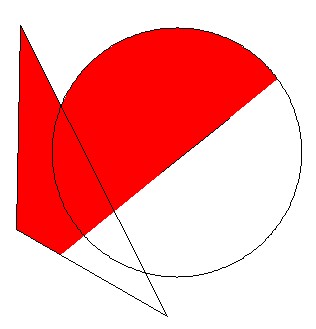
function MT(x,y : double) : boolean;
{
Minterms
}
var
S : boolean;
begin
S := false;
case keer of
0 : S := (not C(x,y)) and (not D(x,y)) and (not L(x,y)); { 000 }
1 : S := (not C(x,y)) and (not D(x,y)) and L(x,y) ; { 001 }
2 : S := (not C(x,y)) and D(x,y) and (not L(x,y)); { 010 }
3 : S := (not C(x,y)) and D(x,y) and L(x,y) ; { 011 }
4 : S := C(x,y) and (not D(x,y)) and (not L(x,y)); { 100 }
5 : S := C(x,y) and (not D(x,y)) and L(x,y) ; { 101 }
6 : S := C(x,y) and D(x,y) and (not L(x,y)); { 110 }
7 : S := C(x,y) and D(x,y) and L(x,y) ; { 111 }
end;
MT := S;
end;
And here comes a vizualization of these elementary pieces of our puzzle:
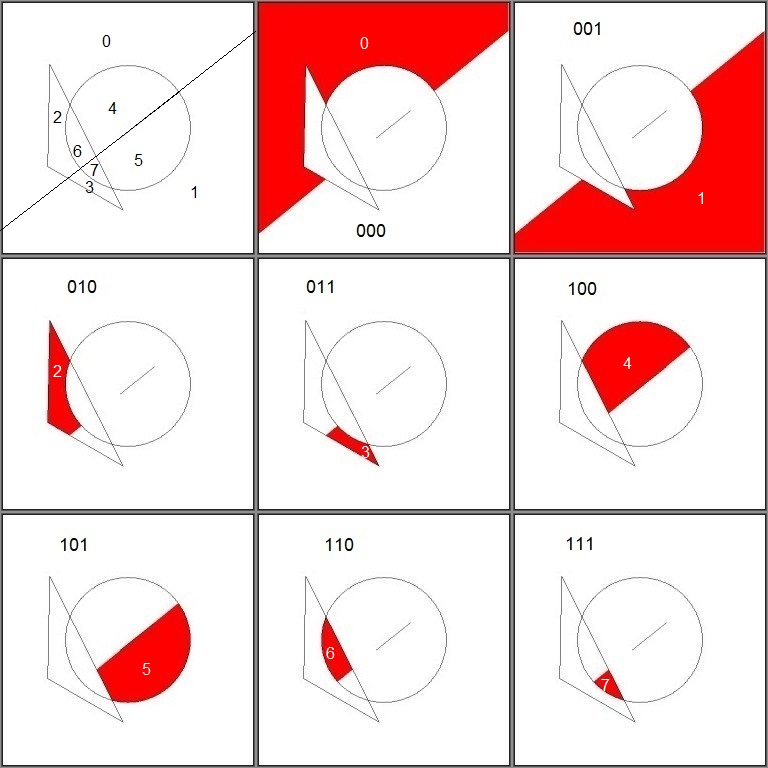
It is observed that the sets $S_k$ with $k=0,1, \cdots ,7$ - also called (equivalence) classes - form a
partition
of the computer screen / the (finite window) plane $\mathbb{R}^2$:
$$ S_k \neq \emptyset $$
$$ ( S_i \neq S_j ) \Rightarrow (( S_i \cap S_j) = \emptyset ) $$
$$ \bigcup_k S_k = \mathbb{R}^2 $$
With the elements of the partition $\left\{S_k\right\}$, any other set in the plane can be composed by union,
such as with the one in the second picture (repeated here for convenience):
$$
S_{246} = S_2 \cup S_4 \cup S_6
$$
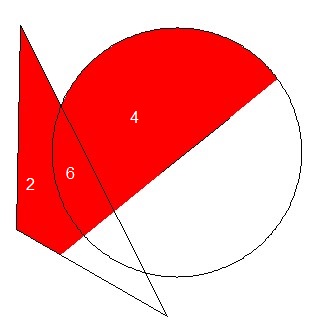
Quite a similar technique is employed with
The Cohen-Sutherland Line-Clipping Algorithm:
take a look at the Outcodes and compare them
with the binary coding for the classes $S_k$ in our partition.
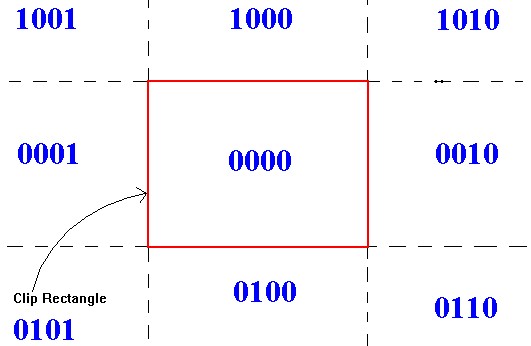

Another obvious similarity is found with Karnaugh maps. Copied without permission from a 1964 book on Boolean algebra by Graham Flegg:
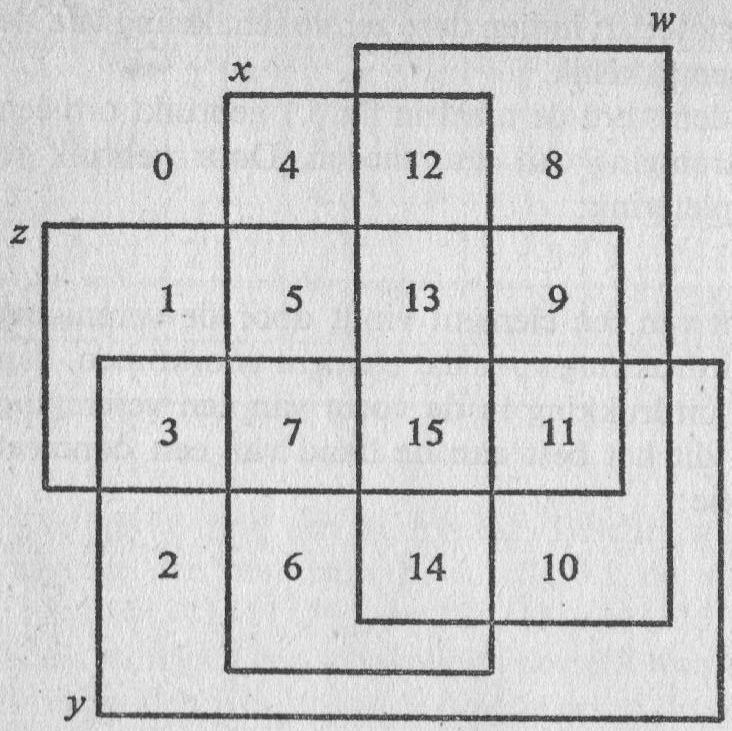
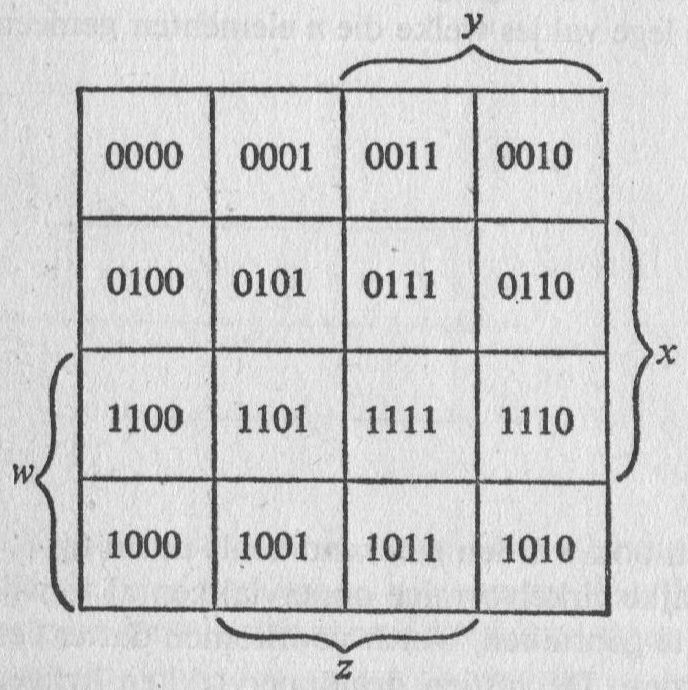
Also read my old musings about Members = Classes in an Elementary Partition.
So far so good, it seems.
Further restriction of our thoughts reveals, however, that each of the above sets is merely a visualization of an open sentence.
Thus the corresponding open sentence, also called predicate (in second order logic), or boolean function (in programming languages),
is the essential thing and the set is just a picture of it. At best there is an equivalence relation between the sets and the predicates.
Maybe the sets even should be replaced by their predicates. All this has already become clear by our programming efforts.
Now let us put forward it formally:
$$
\begin{eqnarray*}
0 = 000 : \quad & S_0(.) = & \neg C \wedge \neg D \wedge \neg L \\
1 = 001 : \quad & S_1(.) = & \neg C \wedge \neg D \wedge \;\; L \\
2 = 010 : \quad & S_2(.) = & \neg C \wedge \;\; D \wedge \neg L \\
3 = 011 : \quad & S_3(.) = & \neg C \wedge \;\; D \wedge \;\; L \\
4 = 100 : \quad & S_4(.) = & \;\; C \wedge \neg D \wedge \neg L \\
5 = 101 : \quad & S_5(.) = & \;\; C \wedge \neg D \wedge \;\; L \\
6 = 110 : \quad & S_6(.) = & \;\; C \wedge \;\; D \wedge \neg L \\
7 = 111 : \quad & S_7(.) = & \;\; C \wedge \;\; D \wedge \;\; L \\
\end{eqnarray*}
$$
We shall see that, with the elementary predicates (minterms) as members, there is a dual set theory.
Let each of the sets $S_k$ be defined as $S_k = \{ S_k(.) \}$ with $k=0,1, \cdots ,7\,$. Then we still have the following easy to prove properties:
$$
S_k \neq \emptyset
$$ $$
( S_i \neq S_j ) \Rightarrow (( S_i \cap S_j) = \emptyset )
$$ $$
\bigcup_k S_k = U
$$
Where $\emptyset$ is the empty set and $U$ is a (restricted) universe. Such is in concordance with:
$$
( S_i(.) \neq S_j(.) ) \Rightarrow (( S_i(.) \wedge S_j(.)) = \mbox{FALSE} ) \\
\bigvee_k S_k(.) = \mbox{TRUE}
$$
With our example, at last:
$$
\{ S_{246}(.) \} = \{ S_2(.) \vee S_4(.) \vee S_6(.) \} = \{ S_2(.)\} \cup \{ S_4(.)\} \cup \{ S_6(.)\} = \{S_2(.) , S_4(.) , S_6(.)\} = \{2,4,6\}
$$
There is a landing on known territory if the story can be continued with:
$$
\{2,4,6\} = 0101010 = 64+16+2 = 82 = \{\, \{\{\{\}\}\} , \{\{\{\{\}\}\}\} , \{\{\{\}\}\{\{\{\}\}\}\} \,\}
$$
The above finally resolves my (very personal) problems with the so-called ZFC Killer Axiom.
In retrospect, it's very simple: members may be predicates. I have just mixed up the specifications with the sets that are constructed with them.